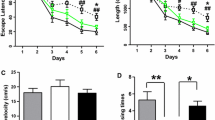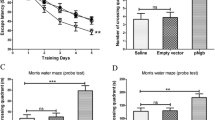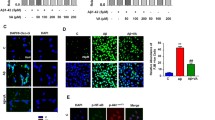Abstract
Beta-amyloid (Aβ) is considered to be responsible for the pathogenesis of Alzheimer’s disease (AD), and accumulation and aggregation of Aβ peptide in the brains of AD patients result in activation of glial cells which, in turn, initiates neuroinflammatory responses that involve reactive oxygen intermediates and release of inflammatory cytokines. In the present study, the protective effects of S-propargyl-cysteine (SPRC), also named as ZYZ-802, a sulphur-containing amino acid, on cognitive impairment and neuronal ultrastructure damage induced by Aβ were examined in rats, and the possible mechanisms were explored. These data showed that SPRC administration at the doses of 40, 80 mg/kg by intraperitoneal injection (i.p.) may inhibit cognitive impairment and neuronal ultrastructure damage induced by intracerebroventricular (i.c.v.) injection of 10 μg of Aβ25–35 in rats. Subsequently, SPRC inhibited the expressions of tumor necrosis factor (TNF)-α, cyclooxygenase-2 (COX-2) mRNA, and protein in rat hippocampus. SPRC afforded a beneficial action on inhibitions of extracellular signal-regulated kinase (ERK1/2), as well as inhibitions of IκB-α degradation and activation of transcription factors of the nuclear factor κB (NF-κB) produced by Aβ. These findings suggested that SPRC might be a potential agent for treatment of AD.






Similar content being viewed by others
References
Akiyama H, Barger S, Barnum S, Bradt B, Bauer J, Cole GM et al (2000) Inflammation and Alzheimer’s disease. Neurobiol Aging 21:383–421
Arancio O, Zhang HP, Chen X, Lin C, Trinchese F, Puzzo D et al (2004) RAGE potentiates Abeta-induced perturbation of neuronal function in transgenic mice. EMBO J 23:4096–4105
Chauhan NB (2006) Effect of aged garlic extract on APP processing and tau phosphorylation in Alzheimer’s transgenic model Tg2576. J Ethnopharmacol 108:385–394
Cheng G, Whitehead SN, Hachinski V, Cechetto DF (2006) Effects of pyrrolidine dithiocarbamate on beta-amyloid (25–35)-induced inflammatory responses and memory deficits in the rat. Neurobiol Dis 23:140–151
Cirrito JR, Yamada KA, Finn MB, Sloviter RS, Bales KR, May PC et al (2005) Synaptic activity regulates interstitial fluid amyloid-beta levels in vivo. Neuron 48:913–922
Cirrito JR, Kang JE, Lee J, Stewart FR, Verges DK, Silverio LM et al (2008) Endocytosis is required for synaptic activity-dependent release of amyloid-beta in vivo. Neuron 58:42–51
D’Intino G, Paradisi M, Fernandez M, Giuliani A, Aloe L, Giardino L et al (2005) Cognitive deficit associated with cholinergic and nerve growth factor down-regulation in experimental allergic encephalomyelitis in rats. Proc Natl Acad Sci USA 102:3070–3075
Delobette S, Privat A, Maurice T (1997) In vitro aggregation facilities beta-amyloid peptide-(25–35)-induced amnesia in the rat. Eur J Pharmacol 319:1–4
Dineley KT, Westerman M, Bui D, Bell K, Ashe KH, Sweatt JD (2001) Beta-amyloid activates the mitogen-activated protein kinase cascade via hippocampal alpha7 nicotinic acetylcholine receptors: in vitro and in vivo mechanisms related to Alzheimer’s disease. J Neurosci 21:4125–4133
Dubois B, Feldman HH, Jacova C, Dekosky ST, Barberger-Gateau P, Cummings J et al (2007) Research criteria for the diagnosis of Alzheimer’s disease: revising the NINCDS-ADRDA criteria. Lancet Neurol 6:734–746
Eikelenboom P, van Gool WA (2004) Neuroinflammatory perspectives on the two faces of Alzheimer’s disease. J Neural Transm 111:281–294
Eikelenboom P, Veerhuis R, Familian A, Hoozemans JJ, van Gool WA, Rozemuller AJ (2008) Neuroinflammation in plaque and vascular β-amyloid disorders: clinical and therapeutic implications. Neurodegener Dis 5:190–193
Flick DA, Gifford GE (1986) Production of tumor necrosis factor in unprimed mice: mechanism of endotoxin-mediated tumor necrosis. Immunobiology 171:320–328
Florent S, Malaplate-Armand C, Youssef I, Kriem B, Koziel V, Escanye MC et al (2006) Docosahexaenoic acid prevents neuronal apoptosis induced by soluble amyloid-beta oligomers. J Neurochem 96:385–395
Ghosh S, Karin M (2002) Missing pieces in the NF-kappaB puzzle. Cell 109:S81–S96
Gong QH, Wu Q, Huang XN, Sun AS, Shi JS (2005) Protective effects of Ginkgo biloba leaf extract on aluminum-induced brain dysfunction in rats. Life Sci 77:140–148
Gong QH, Wang Q, Pan LL, Liu XH, Huang H, Zhu YZ (2010) Hydrogen sulfide attenuates lipopolysaccharide-induced cognitive impairment: a pro-inflammatory pathway in rats. Pharmacol Biochem Behav 96:52–58
Graupera M, García-Pagán JC, Abraldes JG, Peralta C, Bragulat M, Corominola H et al (2003) Cyclooxygenase-derived products modulate the increased intrahepatic resistance of cirrhotic rat livers. Hepatology 37:172–181
Gupta VB, Rao KS (2007) Anti-amyloidogenic activity of S-allyl-l-cysteine and its activity to destabilize Alzheimer’s beta-amyloid fibrils in vitro. Neurosci Lett 429:75–80
Hardy JA, Higgins GA (1992) Alzheimer’s disease: the amyloid cascade hypothesis. Science 256:184–185
Hwang J, Hwang H, Lee HW, Suk K (2010) Microglia signaling as a target of donepezil. Neuropharmacology 58:1122–1129
Ji C, Aisa HA, Yang N, Li Q, Wang T, Zhang L et al (2008) Gossypium herbaceam extracts inhibited NF-κB activation to attenuate spatial memory impairment and hippocampal neurodegeneration induced by amyloid-β in rats. J Alzheimers Dis 14:271–283
Kitazawa M, Oddo S, Yamasaki TR, Green KN, LaFerla FM (2005) Lipopolysaccharide-induced inflammation exacerbates tau pathology by a cyclin-dependent kinase 5-mediated pathway in a transgenic model of Alzheimer’s disease. J Neurosci 25:8843–8853
Koenigsknecht-Talboo J, Landreth GE (2005) Microglial phagocytosis induced by fibrillar beta-amyloid and IgGs are differentially regulated by proinflammatory cytokines. J Neurosci 25:8240–8249
Kowall NW, Beal MF, Busciglio J, Duffy LK, Yankner BA (1991) An in vivo model for the neurodegenerative effects of beta amyloid and protection by substance P. Proc Natl Acad Sci USA 88:7247–7251
Kuang X, Du JR, Chen YS, Wang J, Wang YN (2009) Protective effect of Z-ligustilide against amyloid beta-induced neurotoxicity is associated with decreased pro-inflammatory markers in rat brains. Pharmacol Biochem Behav 92:635–641
Lee SY, Lee JW, Lee H, Yoo HS, Yun YP, Oh KW et al (2005) Inhibitory effect of green tea extract on beta-amyloid-induced PC12 cell death by inhibition of the activation of NF-kappaB and ERK/p38 MAP kinase pathway through antioxidant mechanisms. Brain Res Mol Brain Res 140:45–54
Lee JH, Park SY, Shin YW, Kim CD, Lee WS, Hong KW (2007) Concurrent administration of cilostazol with donepezil effectively improves cognitive dysfunction with increased neuroprotection after chronic cerebral hypoperfusion in rats. Brain Res 1185:246–255
Li Q, Verma IM (2002) NF-kappaB regulation in the immune system. Nat Rev Immunol 2:725–734
Lim GP, Yang F, Chu T, Chen P, Beech W, Teter B et al (2000) Ibuprofen suppresses plaque pathology and inflammation in a mouse model for Alzheimer’s disease. J Neurosci 20:5709–5714
Liu XH, Chen PF, Pan LL, Zhu YZ (2009) 4-Guanidino-n-butyl syringate (leonurine) protects H9c2 rat ventricular cells from hypoxia-induced apoptosis. J Cardiovasc Pharmacol 54:437–444
Maurice T, Lockhart BP, Privat A (1996) Amnesia induced in mice by centrally administered beta-amyloid peptides involves cholinergic dysfunction. Brain Res 706:181–193
McGeer PL, McGeer EG (2007) NSAIDs and Alzheimer disease: epidemiological, animal model and clinical studies. Neurobiol Aging 28:639–647
McGeer PL, Rogers J, McGeer EG (2006) Inflammation, anti-inflammatory agents and Alzheimer disease: the last 12 years. J Alzheimers Dis 9:271–276
McKee AC, Carreras I, Hossain L, Ryu H, Klein WL, Oddo S et al (2008) Ibuprofen reduces Abeta, hyperphosphorylated tau and memory deficits in Alzheimer mice. Brain Res 1207:225–236
Monji A, Utsumi H, Ueda T, Imoto T, Yoshida I, Hashioka SK et al (2002) Amyloid-beta-protein (Abeta) (25–35)-associated free radical generation is strongly influenced by the aggregational state of the peptides. Life Sci 70:833–841
Morris R (1984) Developments of a water-maze procedure for studying spatial learning in the rat. J Neurosci Methods 11:47–60
Mrak RE (2009) Neuropathology and the neuroinflammation idea. J Alzheimers Dis 18:473–481
Murray B, Alessandrini A, Cole AJ, Yee AG, Furshpan EJ (1998) Inhibition of the p44/42 MAP kinase pathway protects hippocampal neurons in a cell-culture model of seizure activity. Proc Natl Acad Sci USA 95:11975–11980
Peng Q, Buz’Zard AR, Lau BH (2002) Neuroprotective effect of garlic compounds in amyloid-beta peptide-induced apoptosis in vitro. Med Sci Monit 8:BR328–BR337
Schwab C, McGeer PL (2008) Inflammatory aspects of Alzheimer disease and other neurodegenerative disorders. J Alzheimers Dis 13:359–369
Selkoe DJ (1999) Translating cell biology into therapeutic advances in Alzheimer’s disease. Nature 399:A23–A31
Shi S, Klotz U (2008) Clinical use and pharmacological properties of selective COX-2 inhibitors. Eur J Clin Pharmacol 64:233–252
Stepanichev MY, Zdobnova IM, Zarubenko II, Moiseeva YV, Lazareva NA, Onufriev MV (2004) Amyloid beta(25–35)-induced memory impairments correlate with cell loss in rat hippocampus. Physiol Behav 80:647–655
Tohda C, Matsumoto N, Zou K, Meselhy MR, Komatsu K (2004) Abeta(25–35)-induced memory impairment, axonal atrophy, and synaptic loss are ameliorated by M1, A metabolite of protopanaxadiol-type saponins. Neuropsychopharmacology 29:860–868
Tyagi E, Agrawal R, Nath C, Shukla R (2007) Effect of anti-dementia drugs on LPS induced neuroinflammation in mice. Life Sci 80:1977–1983
Verdile G, Fuller S, Atwood CS, Laws SM, Gandy SE, Martins RN (2004) The role of beta amyloid in Alzheimer’s disease: still a cause of everything or the only one who got caught? Pharmacol Res 50:397–409
Wang Q, Liu HR, Mu Q, Rose P, Zhu YZ (2009) S-propargyl-cysteine protects both adult rat hearts and neonatal cardiomyocytes from ischemia/hypoxia injury: the contribution of the hydrogen sulfide-mediated pathway. J Cardiovasc Pharmacol 54:139–146
Wang Q, Wang XL, Liu HR, Rose P, Zhu YZ (2010) Protective effects of cysteine analogues on acute myocardial ischemia: novel modulators of endogenous H(2)S production. Antioxid Redox Signal 12:1155–1165
Webster B, Hansen L, Adame A, Crews L, Torrance M, Thal L et al (2006) Astroglial activation of extracellular-regulated kinase in early stages of Alzheimer disease. J Neuropathol Exp Neurol 65:142–151
Yamada K, Nabeshima T (2000) Animal models of Alzheimer’s disease and evaluation of anti-dementia drugs. Pharmacol Ther 88:93–113
Yankner BA, Duffy LK, Kirschner DA (1990) Neurotrophic and neurotoxic effects of amyloid beta protein: reversal by tachykinin neuropeptides. Science 250:279–282
Acknowledgments
This work was supported by the National Basic Research Program of China (973 Program, Grant No. 2010CB912600), National natural Science foundation of China (Grant No. 30888002) and National Drug Innovative Program (2009ZX09301-011).
Author information
Authors and Affiliations
Corresponding author
Rights and permissions
About this article
Cite this article
Gong, QH., Pan, LL., Liu, XH. et al. S-propargyl-cysteine (ZYZ-802), a sulphur-containing amino acid, attenuates beta-amyloid-induced cognitive deficits and pro-inflammatory response: involvement of ERK1/2 and NF-κB pathway in rats. Amino Acids 40, 601–610 (2011). https://doi.org/10.1007/s00726-010-0685-1
Received:
Accepted:
Published:
Issue Date:
DOI: https://doi.org/10.1007/s00726-010-0685-1




